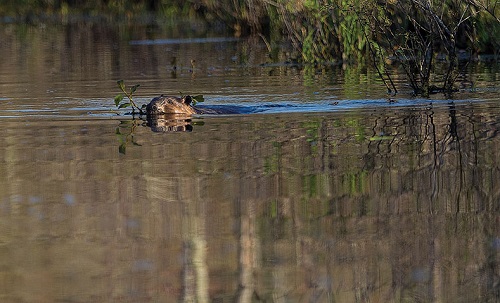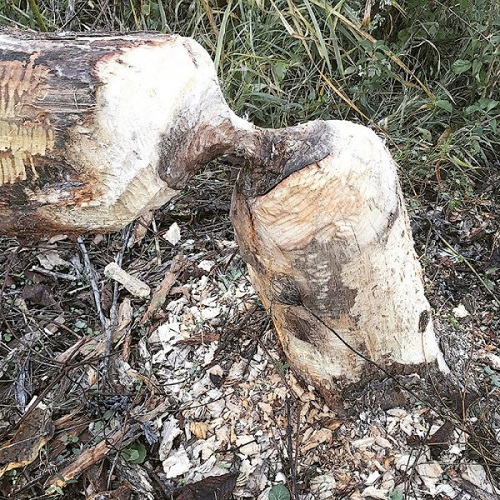 Once valued as little more than pelts, beavers are back in vogue and rebuilding their reputation as habitat engineers. It helps their cause that the dams they build as homes also create water quality-boosting wetlands and habitat for other species. In the process, the structures slow the flow of water and filter out sediment that would otherwise be on its way to the Chesapeake Bay.
Once valued as little more than pelts, beavers are back in vogue and rebuilding their reputation as habitat engineers. It helps their cause that the dams they build as homes also create water quality-boosting wetlands and habitat for other species. In the process, the structures slow the flow of water and filter out sediment that would otherwise be on its way to the Chesapeake Bay.

And a new study out of the Northeast suggests the dams, which can alter the course of entire river systems, can also substantially reduce the amount of nitrogen in them.
Arthur Gold, chair of the natural resources science department at the University of Rhode Island, along with graduate student Julia Lazar, was interested in the role of certain landscapes in cleaning up waters before they reach key estuaries. With a focus on natural resources, the team looked for important landscape features that have “pollution-cleansing capacity.”
Beaver dams “had all the ingredients,” Gold said.
The researchers knew beaver dams deployed wet, organic soils to trap nitrates, but could they also transform it into a gas that would float away from the water altogether?
The answer, it turns out, is yes.
“That meant that, even if the beaver pond broke and the sediment washed back in, the beaver pond reduced the [nitrogen] load that was moving through the system,” Gold said.
The larger beaver ponds they studied removed up to 45 percent of the nitrogen from the water that moved through them, while smaller ponds removed closer to 5 percent. Gold said some of the lower removal rates were in ponds that had little nitrogen work to do in the first place because they filtered forested landscapes.
The North American beaver, or Castor canadensis, was the native landscaper of local river systems until settlers trapped them to near extinction in the 1800s. Their populations have made a comeback in recent years; one small watershed in Rhode Island, for example, saw its beaver numbers grow from none to 92 over the last 30 years, Gold said.
“They’ve come back to a landscape with much more nitrogen in it,” he said, “So, because of the conditions that beaver ponds create, we now have a new removal ecosystem that we didn’t have.”
In the years since the beaver’s near demise and its triumphant return, the Northeast and mid-Atlantic have welcomed sprawling population centers and larger farms, at the cost of the forested landscapes to which their beaver predecessors were accustomed.
But the beavers don’t seem to mind. They’ve learned to settle in the midst of rural, suburban and even urban environments, sometimes to the chagrin of their nearest neighbors. While beavers can still be hunted or trapped, their primary problem is the NIMBY reaction that an unwanted dam can solicit.
Even though the dams beavers create are a boon for water quality, “people think of these animals sometimes as pests, and they don’t want to deal with them as a nuisance,” said Sujay Kaushal, an associate professor in the University of Maryland Department of Geology and Earth System Science.
A hydrologist by training with a pair of degrees in biology as well, Kaushal said stream restoration projects, like the ones he works on, “mimic the work of some of these ecological engineers like the beaver.”
But beavers don’t work off the same blueprints — or take subdivisions and roads into account — when they decide to dam a stream or culvert as part of their new abode.
John Griffin, director of urban wildlife programs at the U.S. Humane Society, said beavers are often embroiled in conflicts when their dams result in flooding or other impacts to the developments around them.
“When people are living in an urban area, they think that animals belong in a natural habitat — not here,” he said. “We’re not thinking about there being a functioning ecosystem here.”

The problems arise when both humans and beavers build their homes around natural water features, and each has impacts on the other. But, Griffin said, there are solutions that allow both to be good neighbors.
Residents can use tree guards to protect their expensive ornamentals from beavers’ teeth. Rather than destroying dams or trapping beavers, they can mitigate the impact of rising water tables with devices like the “beaver deceiver,” which uses pipes to channel water through the dam while giving the beaver the feeling of damming the stream.
Beavers and their dams also bring new habitats to urban and suburban environments, creating the wetlands known to be key to several species’ survival. Griffin said more people are warming to the idea that a beaver can bring benefits to the neighborhood.
“On a larger scale, there is the realization that we have shrinking wetlands. Harnessing these creatures to [create wetlands] in places where it’s possible is a great way to control runoff and create new systems,” he said.
Kaushal said that work is often done by developers, who create makeshift wetlands where they want them to mitigate stormwater from new construction. But there’s a place for beavers, too.
In more rural environments, beavers not only have room to roam but their dams can help remove excess nitrogen associated with septic systems and animal farms. That impact can be even more powerful if we make room for dams — or simply conserve patchworks of the landscape — between urban and rural areas throughout the watershed.
“By conserving the area and creating places for the beaver, you may not have to go in later on and install stormwater management,” Kaushal said. “You could have a [nitrogen-absorbing] sink that’s there by just conserving some of the land.”
Beavers, like humans and oysters, not only live in the natural environment but also modify it to suit their needs. In the process, beavers have carved out a reputation for themselves as the “quintessential riparian animal,” as one report put it, a keystone species for the establishment of new ecosystems on which several other species rely.
Newly flooded forest ponds attract herons to form new rookeries and eagles to find new feeding grounds. Amphibians flourish in the shallow ponds and juvenile fish find room to grow.
In the West, natural resource departments have deployed beavers to help restore watersheds, where the ponds they create become rich with invertebrate life.
But beaver dams are also the foundation for “a riot of plant life,” Gold said. The plants contribute to the ponds’ ability to remove nitrogen from the water.
When that plant material dies in the fall, Gold explained, the microbial community has a feast similar to what takes place in a compost pile. They need oxygen to fuel this decomposition, but there’s only so much to be had in a beaver pond.
The researchers found that those microbes are then able to use an alternate source of oxygen by stripping one of the oxygen molecules from the nitrate molecule, made up of one nitrogen atom and three oxygen atoms. Subsequent steps carried out by anaerobic bacteria in the wet soil strip the remaining oxygen atoms and may ultimately free the nitrogen atoms, a gas, and allow it to leave the watershed.
The chemical process is the same as what happens in a streamside wetland as it filters runoff from adjacent land. But, unlike a riparian filter, beaver ponds might be filtering — and removing nitrogen from — water that’s flowed off an entire watershed, perhaps 2,000 acres.
Gold thinks this research makes the case for beaver dams interspersed throughout a stream system and, as often as possible, downstream from major sources of nitrogen pollution.
“If we have a mosaic or patches of rural [areas] mixed in with development, there’s an opportunity for beaver ponds” to do their work, he said.
Urban parks can be a great place for beavers to redefine the landscape, as they have at Bladensburg Waterfront Park along the District of Columbia’s stretch of the Anacostia River. Jorge Bogantes Montero, stewardship program specialist in natural resources for the Anacostia Watershed Society, said three beaver dams constructed in one stretch of the park demonstrate their ability to attract wildlife and clean the water even in the middle of the city.
There, he said, you can see firsthand “how beaver engineering inspired these new systems that bioengineers use for stream stabilization.”
During paddling events, he often sees the resident beavers at work on the river where he said they are increasingly common. Their presence may lead the organization to protect more of the trees it plants — beavers took down one they planted seven years ago that had grown to 8 inches in diameter — and to make more room for the wetland creators to do their best work.
Kaushal agrees that there’s room for them in these urban landscapes, especially as we learn more about their pollution-removal capacity.
“We need to, I don’t want to say embrace the beaver, but it’s a bigger symbol of some bigger things,” he said.
